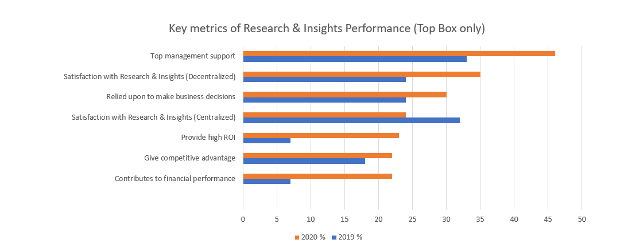When I first arrived in the United States in January 1991, the first conference I attended was the inaugural meeting of the Research Industry Leaders Forum, a gathering of corporate market research function leaders and agency CEOs. It was held in a dingy motel-cum-conference centre, and outside, the skies were leaden and the ground covered in thick snow. Inside, the atmosphere was equally dreary, with client leadership bemoaning their lack of a ‘seat at the table’. What this meant was that they were not part of the decision-making fabric of their respective companies and were instead relegated to being tactical cost centres in the bowels of their business. This refrain carried on for years.
And it was true! Research was indeed confined to the basement, seen as a cost line item on the P&L, and one of the first to be cut in times of recession. In 2009, a comprehensive study of insights management in major corporations by Boston Consulting Group found that only 10% of insights functions qualified as being either strategic partners or sources of competitive advantage. Granted, by 2015, when BCG – alongside Cambiar and Yale University – repeated the study, that proportion had doubled to 20%. But this was still a disappointingly small number of functions that could claim that famed ‘seat at the table’.
The arrival of COVID
Then, along came COVID. With consumer behaviour rapidly changing, all the models on which companies had been relying became moot. The urgent questions became, “what’s happening?”. C-Suites the world over needed answers, and they needed them quickly. Insights functions became essential founts of real-time data and understanding. Then the question mutated to “what’s going to happen?” and now insights functions were engaged in foresight and scenario planning. Finally, the question changed to “how are we going to compete?” and those same functions found themselves in the heat of critical decision-making.
And the great news is we rose the occasion!
In 2021, the ARF published a study among their corporate members, which showed a very significant increase in recognition for the role played by insights functions in the success of their organisations.
 Source: ARF Second Organizational Benchmark Study 2021. N = Advertiser Senior Management (US)
Source: ARF Second Organizational Benchmark Study 2021. N = Advertiser Senior Management (US)
What is significant here are the results shown in the lower half of this chart: the proportion of senior managers strongly agreeing that research and insights (including analytics) provided a high ROI, gave the firm a competitive advantage and contributed to financial performance. All of these were way ahead of the 2015 benchmarks cited earlier. And, what’s more, a key driver of this seems to be the degree to which the insights functions received top management support.
In other words, insights got a seat at the table. The question now is how can we stay there?
Staying there
In the 2015 study, there emerged a series of conditions necessary for an insights function to be viewed as a strategic partner or, even better, a source of competitive advantage, among which were:
Senior management championship (CMO is fine, but CEO is way better)
Control of the budget
A focus on strategic foresight
Engagement across the business and in the business.
To this, we would add the ‘power skills’ necessary to translate insights into action – the ability to influence, consulting skills, storytelling and the ability to spread the story throughout the business. All of this has tremendous implications not only for the structure of insights functions but also the talent that’s needed and the skill sets that are required of that talent. In the book Leading Edge of Marketing Research (Sage, 2012), Ian Lewis and I posited that, in addition to core researchers and project managers, insights functions of the future would need specialists (behavioural scientists, AI and Machine Learning, data management systems specialists and others), polymaths (to connect the dots from diverse data sources and divine the story), and consultants to take the story to senior management and tell it in a compelling way that would lead to action. It appears that we were right. These are indeed the skill sets and profiles that insights functions search for today.
But, in addition to that, insights functions are also being called upon to be accountable and to measure the impact that they have on business outcomes. Increasingly, strategically-central insights departments are having to measure – preferably in financial terms – the return on investment that they bring to the party. Seminal research by GRBN and BCG showed that doing so actually resulted not only in greater respect for the function but also larger budgets and more resources. We are now seeing that in the growth reported not only by ESOMAR but by national associations such as the Insights Association in the U.S. and the MRS in the U.K. ESOMAR reported over 10% growth in the overall sector in 2021 and 5% in “established research” while in the U.S. the equivalent figures were over 16% and 6% respectively. The more central insights are to businesses and organisations, the more we see the industry grow.
As it does so, the final question I would posit is how can providers, especially those in “established research”, contribute not only to continued growth but to the maintenance of their clients’ seat at the table? The answer, I believe, is by being more than a “vendor” (a word that should be banished from all our vocabularies) or a supplier and becoming partners to our clients’ strategic journeys. We can do this by adding strategy consulting and design skills to our armoury, by honing our own storytelling skills and involving ourselves more deeply in their quest to prove their value and measure their impact on their businesses.
An industry that has been frequently accused of being slow to change has proved exactly the opposite in the last few years. It’s not just about the technology (although that has been a huge factor), but it’s also about our role in keeping our clients’ seat at the table. We are at the cusp of a new dawn in the age of insights.
Let’s not blow it.
Simon Chadwick
Managing Partner at Cambiar Consulting, Editor in Chief of Research World at EsomarSimon founded Cambiar in 2004 to provide strategic assistance to research and insight companies as they face rapid and fundamental change. With 40 years of guiding and managing international organizations of various sizes and stages, Simon’s advice and counsel has helped many companies increase their value – to stakeholders, investors and clients.
He is an acknowledged industry leader, author and conference speaker. In addition to his role at Cambiar, Simon is also a Fellow of the Market Research Society, past Chairman of the Insights Association and Editor-in-Chief of Research World, ESOMAR’s global magazine.
He holds an MA in Philosophy, Politics and Economics from Oxford University, UK, and has done post-graduate studies at both Columbia and Harvard business schools in Change Management and Strategic Management.



